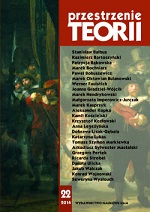W labiryntach czasu i wieczności. O Lśnieniu Stanleya Kubricka
In the labyrinth of time and eternity: on Stanley Kubrick’s The Shining
Author(s): Kamil KościelskiSubject(s): Film / Cinema / Cinematography, Theory of Literature
Published by: Uniwersytet Adama Mickiewicza
Keywords: movie; time concept; labyrinth theme; eternity; Kubrick; Borges;
Summary/Abstract: In the interview which appeared after the premiere of The Shining, Kubrick said that the fantastic qualities of reality in his movies are “treated in a very […] ordinary way”. He indicated that uncanny events are also depicted in this way in Jorge Luis Borges’ writings. The comparison made by Kubrick should not be disregarded since the labyrinth motif, which does not appear in Stephen King’s book that has been adapted for the screen, is an important theme in Borges’ works as well as in The Shining. The Garden of Forking Paths, which was also written by this Argentinian writer, not only explores the above-mentioned motif, but also describes the conception of time which can be found in The Shining and in the last scene of Kubrick’s 2001: A Space Odyssey. Borges’ literary works might be helpful in comprehending Kubrick’s notion of the fourth dimension. The coexistence of different times in The Shining, in turn, refers to the theological idea of eternity. This conception corresponds to the main character’s nature – especially his desires, aspirations and anxieties. The established perspective provides an opportunity to exemplify what Kubrick meant by showing the fantastic qualities of reality “in a simple, non-baroque style”.
Journal: Przestrzenie Teorii
- Issue Year: 2014
- Issue No: 22
- Page Range: 171-187
- Page Count: 17
- Language: Polish

